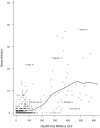Impact of Health Aid Investments on Public Opinion of the United States: Analysis of Global Attitude Surveys From 45 Countries, 2002-2016
- PMID: 31095407
- PMCID: PMC6603455
- DOI: 10.2105/AJPH.2019.305084
Impact of Health Aid Investments on Public Opinion of the United States: Analysis of Global Attitude Surveys From 45 Countries, 2002-2016
Abstract
Objectives. To assess whether increasing health aid investments affected public opinion of the United States in recipient populations. Methods. We linked health aid data from the United States to nationally representative opinion poll surveys from 45 countries conducted between 2002 and 2016. We exploited the abrupt and substantial increase in health aid when the US President's Emergency Plan for AIDS Relief (PEPFAR) and President's Malaria Initiative (PMI) were launched to assess unique changes in opinions of the United States following program onset. We also ascertained increased exposure to health aid from the United States by systematically searching for mentions of US health aid programs in popular press. Results. Favorability ratings of the United States increased within countries in proportion to health aid and were significantly higher after implementation of PEPFAR and PMI. Higher US health aid was associated with more references to that aid in the popular press. Conclusions. Our study was the first, to our knowledge, to show that US investments in health aid improved the United States' image abroad. Public Health Implications. Sustained global health investments may offer important returns to the United States as well as to the recipient populations.
Figures



Comment in
-
Development Assistance for Health: Going Beyond Recipient Country Needs to Donor Country Benefits.Am J Public Health. 2019 Jul;109(7):961-963. doi: 10.2105/AJPH.2019.305145. Am J Public Health. 2019. PMID: 31166744 Free PMC article. No abstract available.
-
Public Health, Politics, and the Creation of Meaning: A Public Health of Consequence, July 2019.Am J Public Health. 2019 Jul;109(7):966-968. doi: 10.2105/AJPH.2019.305128. Am J Public Health. 2019. PMID: 31166747 Free PMC article. No abstract available.
References
-
- Dieleman JL, Schneider MT, Haakenstad A et al. Development assistance for health: past trends, associations, and the future of international financial flows for health. Lancet. 2016;387(10037):2536–2544. - PubMed
-
- Dzau V, Fuster V, Frazer J, Snair M. Investing in global health for our future. N Engl J Med. 2017;377(13):1292–1296. - PubMed
-
- Fauci AS, Eisinger RW. PEPFAR—15 years and counting the lives saved. N Engl J Med. 2018;378(4):314–316. - PubMed
-
- Gupta V, Kerry VB. Globally inclusive investments in health: benefits at home and abroad. BMJ. 2017;356:j1004. - PubMed
-
- Office of Management and Budget. Budget of the US government fiscal year 2018: a new foundation for American greatness. 2017. Available at: https://www.whitehouse.gov/sites/whitehouse.gov/files/omb/budget/fy2018/.... Accessed October 20, 2107.
MeSH terms
LinkOut - more resources
Full Text Sources
Medical

